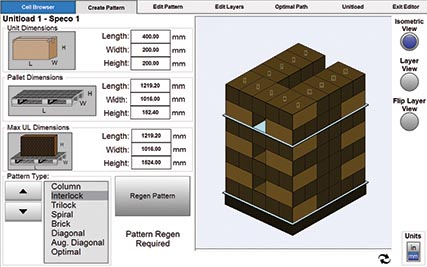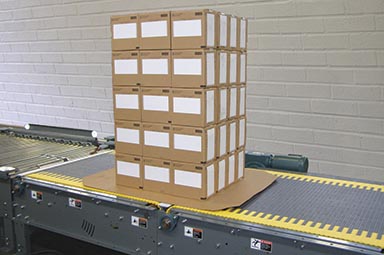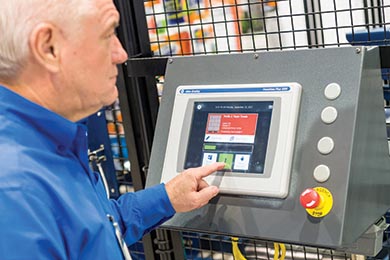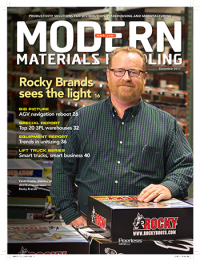Finding Answers to: No Time, No Tools, No Talent
The latest developments in unitizing equipment and software are helping customers tackle packaging challenges.
Manufacturers of unitizing equipment—including conventional and robotic palletizers and stretch wrap machines—are unveiling new features in their offerings that address the oft-heard lament from their customers: “no time, no tools, no talent.”
The “time” part refers to the higher throughput rates experienced at the end of packaging lines producing shorter runs of different types of products with highly variable packaging types. With sustainability on the mind of consumers and manufacturers, less and less packaging is being used to protect products during shipping and handling—making them far more fragile and challenging to unitize (think shrink-wrapped bundles with no corrugated tray underneath). Doing so properly requires more time in a manual operation.
Further, the increased product and packaging variety results in more frequent changeovers. Packers are increasingly relying on automation to accommodate those modifications with minimal operator intervention (“no tools”). They also want machines that are easy to access for cleaning, maintenance and supply replenishment, such as restocking stretch film.
Finally, “no talent” is not a comment on the skill sets possessed by the current labor force, but rather an acknowledgment of the difficulty in finding and hiring workers. Finding personnel to fill shifts around the clock has become increasingly difficult. That means facilities want more semi- and fully-automated unitizing solutions that deliver consistently gentle handling. They also want layer-forming flexibility with foolproof, intuitive interfaces that guide less experienced, busier-than-ever operators as they build and wrap stable unit loads efficiently and securely.
Here, Modern takes a look at four new ways today’s unitization manufacturers are addressing these load-building and wrapping challenges.
1.) Robotic palletizing, load building made easier with intuitive, on-machine software
To help customers simultaneously optimize and simplify pallet load building with its robotic palletizers, Schneider Packaging Equipment recently added its proprietary OptiStak software to its machines, explains Mike Brewster, director of sales and marketing.
 Load building software on robotic palletizers guides a worker through the selection of case sizes and pack patterns, then creates and recommends the optimal recipe.
Load building software on robotic palletizers guides a worker through the selection of case sizes and pack patterns, then creates and recommends the optimal recipe.
|
“The software allows operators to create and edit stack patterns directly on the machine’s human machine interface (HMI),” Brewster says. “They can create optimal recipes in one click, customize pack patterns quickly, and then instantly see the incorporated changes through the software’s 3D interface.”
Designed to be intuitive, unintimidating and easy to learn, the software guides a worker through the selection of case size and pack pattern, then creates and recommends the optimal recipe. For operations feeding a single palletizer from multiple case-packing lines handling different stock keeping units (SKUs), the ability to adjust patterns on the fly minimizes downtime during changeovers, Brewster adds.
“There’s no guesswork involved. With operations struggling to find qualified employees all while maintaining production levels with different types of products coming from multiple case lines, the software decreases the amount of time an operator might spend trying to figure out the ideal arrangement,” Brewster says. “It also ensures that each pallet has the maximum amount of product on it that it can possibly hold, which further helps increase return on investment.”
The ability to manipulate and select palletizing patterns right on the machine itself prevents a common occurrence with most systems, adds Brewster. “Often, robotic palletizing cells require a computer separate from the machine to add or modify a pattern,” he says. “Typically, the offline software requires someone at the company to be trained or have a service technician on site. In most scenarios, this is eliminated with OptiStak.”
2.) Combination solutions remove handling steps, increase operational flexibility
Conventional palletizers are also being engineered to support flexibility and convenience. Part of delivering against both of those objectives means that manufacturers like Columbia Machine are now designing and producing combination systems that integrate multiple unitizing processes and machinery into a single turnkey solution, says Ted Yeigh, sales director.
 Palletizing software now enables machinery to build stable loads that accommodate shippers who wish to remove pallets from their unit loads completely as a costsavings approach.
Palletizing software now enables machinery to build stable loads that accommodate shippers who wish to remove pallets from their unit loads completely as a costsavings approach.
|
“At the Pack Expo Las Vegas show this fall, we introduced the new FL6200SW conventional palletizer with an integrated stretch wrapper to help particularly with securing loads with a higher potential for instability or operations with space constraints,” Yeigh explains. “The machine simultaneously stacks and stretchwraps a variety of the more challenging package types we’re seeing with increasing frequency these days—including unwrapped trays, shrink pads, film-only bundles and more.”
Not only does the system use servo control technology with a high-speed turntable and stretch wrapper to handle up to 100 cases per minute, but it can also be implemented with one or more of Otto Motors’ self-driving vehicles (SDV) with a payload capacity of 3,400 pounds, Yeigh continues.
“With more companies implementing multiple pack lines, yet having fewer workers available, the SDVs offer a more flexible means to transport loads from a palletizer, or from an array of multiple palletizers to a single stretch wrapper,” he says. “Previously, unless they were using operators with forklifts, companies had to install a transfer car on rails that was guarded to protect operators or a full-load conveyor with 90-degree transfers.”
Those solutions, Yeigh says, are both expensive and fixed. They also obstruct access to the machinery, which could negatively affect operational efficiency. “The SDVs create free, open access to the discharge point, as well as to other equipment in the area, such as case erectors,” he continues. “Further, they navigate autonomously, independent of sensors embedded in the floor or laser reflectors. Instead, the vehicles use integrated memory and encoder wheels to determine their location and are programmable with tablets.”
3.) Palletizers create inherent load stability, independent of shipping platform
Regardless of whether they’re robotic or conventional, palletizers in general are getting smarter about how they build every type of load, says Doug Stoll, palletizing product manager at Honeywell Intelligrated.
“The issues we address with our palleting software revolve around building the most stable, solid load possible so it is not compromised during transportation, for example. The software has to be flexible enough to be easily and quickly changed to handle reusable manufacturing totes, corrugated boxes or even bagged product based on the needs of that particular unit load,” Stoll explains.
The reason, he adds, is that packers are making every effort to accommodate the end destination of the products—which, in certain cases, might mean a switch in shipping platform either mid-stream or upon arrival at the final delivery point.
“Some of our customers might be shipping to a third party or an overseas destination where the load is transferred onto a composite or less-common dimension pallet than what we use here in the United States,” Stoll continues. “Many have to consider all the different substrates their unitized loads might be shipping on, and they rely on us to build a load that can be gripped with a clamp truck instead of a forklift.”
Further, some companies are simply trying to do away with pallets altogether as a cost-savings approach for handling very regular, consistent loads of the same item, Stoll continues. “They might use slip sheets or corner boards or even plywood and banding instead of stretch wrap,” he explains. “It very much depends on the situation, but for a manufacturer looking to overcome pallet cost or quality challenges, it presents a unitizing challenge that our software can accommodate.”
4.) Intuitive user interface takes guesswork out of stretch wrapping
To minimize load damage in shipping, Lantech has determined that operations need to adjust 12 different stretch wrap machine settings prior to wrapping the load, says Pat Lancaster, founder and chairman of Lantech.
 A simple, graphical software interface on semi- and fully automated stretch wrap machines prompts users to make a series of choices about the load.
A simple, graphical software interface on semi- and fully automated stretch wrap machines prompts users to make a series of choices about the load.
|
“Many companies have pulled resources out of the back end of their plants to save labor; there’s no longer any process engineering going on there,” Lancaster says. “For that reason, we’ve developed a simple, graphical, intuitive software interface on all of our semi- and fully automated machines that prompts users to make a series of choices about the load. The software then recommends a load-wrapping profile that can be accepted and saved, or edited if necessary.”
When creating a new load profile, or editing an existing one in the Load Guardian system, an operator navigates through a series of visual choices, including load height, uniformity, inboardness (distance from load to pallet edge), the gauge and width of film, turntable and elevator speed, and film tension.
Once accepted and the wrapping begins, force and layer adjustments can be made with up/down arrow clicks. “We’ve also included a degree of education,” says Lancaster. “If an operator clicks tension down too far, an alarm says, ‘Be careful. You may be going below the recommended containment force and might get damage.’ Or, if they go above that number, the alarm says, ‘Be careful. You might be crushing the load with too much force.’”
Further, he continues, certain editing and machine operation sequences will engage an on-screen video explaining the problem—such as a film break—and steps to resolve it. “Because the machines are making the right decisions and coaching the operators against making modifications that could cause problems, we’ve found more machines with settings exactly the same as when we installed them six months ago,” he adds.
Companies mentioned in this article:

Article Topics
Packaging News & Resources
Pack Expo East has largest show to date Optimize Parcel Packing to Reduce Costs CMC Packaging Automation North America unveils Tech Center in Atlanta PACK EXPO East brings latest packaging technologies to Philadelphia Loftware’s cloud-based labeling solutions take center stage Flexcon unveils its innovative bin solutions PAC Machinery’s newest sustainable packaging options save money while increasing productivity More PackagingLatest in Materials Handling
NetLogistik partners with Vuzix subsidiary Moviynt to offer mobility solutions for warehouses Materials Handling Robotics: The new world of heterogeneous robotic integration Lucas Watson appointed CSO for Körber’s Parcel Logistics business in North America Hyster recognizes Dealers of Distinction for 2023 Carolina Handling names Joe Perkins as COO C-suite Interview with Keith Moore, CEO, AutoScheduler.AI: MODEX was a meeting place for innovation Walmart deploying autonomous lift trucks at four of its high-tech DCs More Materials HandlingAbout the Author
Subscribe to Materials Handling Magazine

Find out what the world's most innovative companies are doing to improve productivity in their plants and distribution centers.
Start your FREE subscription today.
April 2024 Modern Materials Handling

Latest Resources












